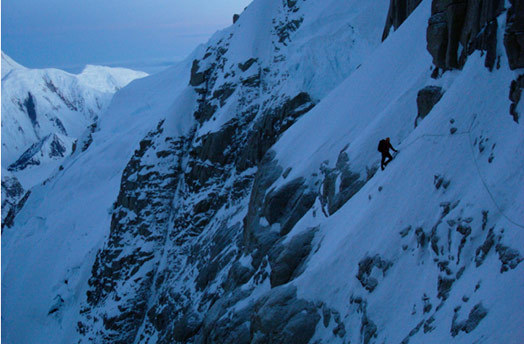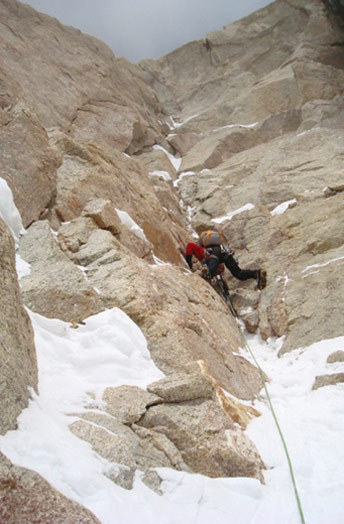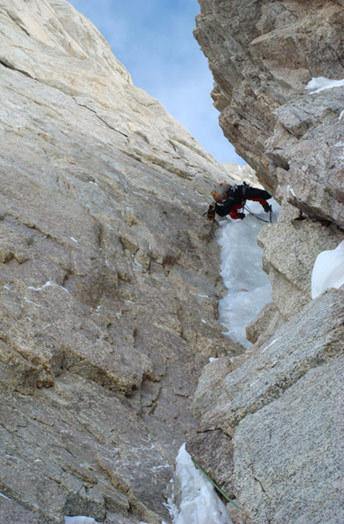
Colin Haley on the lower section of the Denali Diamond (Alaska Grade 6: 5.9 A3, 7,800′, Becker-Graage, 1983), Denali, Alaska Range, Alaska, during the fifth ascent. Haley and Mark Westman managed the climb in less than forty-eight hours; the first ascent took seventeen days. [Photo] Mark Westman
On June 17, Alaska range veteran Mark Westman and alpinism’s hot young protege Colin Haley began up the Denali Diamond (Alaska Grade 6: 5.9 A3, 7,800′, Becker-Graage, 1983) on Denali’s (20,320′) massive south face. Forty-five hours and forty minutes later, they became the fifth team to complete the route. In doing so, they may have also ushered in Denali’s new alpine benchmark.
For years, the Cassin Ridge (Alaska Grade 5: 5.8 65 degrees, 8,800′, Cassin-Canali-Alippi-Perego-Airoldi-Zucchi-Goodwin, 1961) has been the classic hard alpine route on the mountain. While not Denali’s most difficult climb–routes such as the Slovak Route (Alaska Grade 6: M5 WI6 5.9, 8,500′, Adam-Krizo-Korl, 1984), Light Traveler (Alaska Grade 6: M7+ WI6, 8,500′, Koch-Prezelj, 2001) and Canadian Direct (Alaska Grade 6: M6 5.9, 8,000′, Menard-Turgeon, 2006), all on the south face, feature harder climbing–it has been the climb against which aspiring alpinists tested themselves for more than a generation. But with rising standards, climbers are seeking out more difficult outings, and the Denali Diamond, just around the corner from the Cassin and joining it at 17,500′ for the summit snowfields, is shaping up as a modern classic.
The route began as an epic. In 1983, Rolf Graage, who, according to High Alaska, “was obsessed with becoming a world-class climber”, hired Bryan Becker to bring him onto Denali’s southwest face. The route they chose proved severe, and the fact that they forgot their ice screws (Becker bought two in Talkeetna to bring along at the last minute) and their lead rope (the pair climbed the route on a nine-mil haul line) did nothing to lessen the challenge. The climb involved thirty-seven pitches, including a twenty-five-foot A3 roof followed by what Becker described as “the most difficult, sustained, mixed aid/ice pitch of my life.” They were hit by numerous spindrift avalanches, Graage took a sixty-five-foot leader fall, was swept off the face while still in the tent, and lost his sleeping pad en route, and they finished the climb seventeen days after beginning (the weather permitted climbing on only nine of them).
In 2002, Ian Parnell and Kenton Cool considerably improved upon the first ascent when they made the second in five days, using only two points of aid (they avoided the A3 roof at the top of the 3,000-foot wall by climbing a variation to the left that they estimated would go at M7). Next up were the strong young Japanese alpinists Fumitaka Ichimura and Katsutaka Yokoyama in 2005, who climbed it, like the Britons, in five days. The same season Chris Brazeau and Ian Welsted managed the fastest ascent to date, climbing it in forty-four hours ‘schrund to summit (due to spindrift, they avoided the entire upper crux corner by going left and climbing circuitous and difficult terrain–possibly via the Roberts/McCartney finish–that was nonetheless apparently a bit easier than the Denali Diamond’s crux corner).

Haley beginning up the crux section, which he climbed at M6 A1, of the Denali Diamond. The original ascent of the route, by Rolf Graage and Bryan Becker in 1983, took a twenty-five-foot roof to the right that subsequent ascensionists have avoided by ascending the corner system above Haley. It has yet to go entirely free, but with modern tools and techniques, the route’s increasing popularity and the system’s abundant features, a complete free Denali Diamond is only a matter of time. [Photo] Mark Westman
Calling the Denali Diamond Denali’s new alpine benchmark is not to say that all aspirants need apply. Apart from Graage, everyone who has been on the route has earned the right to climb it. This year’s ascent proved no exception. Westman is an unsung hardman of the range, having established numerous new routes in the Ruth Gorge including Once Were Warriors (V WI6 mixed, 17 pitches) on Mt. Grosvenor (8,460′) (for a sendup of his unheralded status, see Alpinist 19 ). The young Haley is enjoying an annus mirabilis: after coming onto the radar screens in 2006 with the greatly underrated first ascent of Mt. Moffit’s Entropy Wall (VI 5.9 A2 WI4+, 2400m, Brown-Haley, 2006), which he managed with frequent partner Jed Brown, he has exploded in 2007. In January he made the first linkup, with Kelly Cordes, of A la Recherche du Temps Perdu (ED+, 800m, Marsigny-Parkin, 1994) and the Ferrari West Face (ED+, 1000m, Chiapi-Conti-Ferrari-Negri, 1974) on Patagonia’s Cerro Torre. In March, he and Brown managed the first winter ascent of Alaska’s Mt. Huntington, via the West Face Couloir (Alaska Grade V: 85 degrees, 3,250′). And from May 25-27, Haley teamed up with Steve House for the first ascent of the Haley-House (WI5 M8, 8,200′) on Mt. Robson (12,989′).

Haley enjoying sticker ice on the fifth ascent of the Denali Diamond (Alaska Grade 6: 5.9 A3, 7,800′, Becker-Graage, 1983). [Photo] Mark Westman
In late May, Haley and Westman warmed up for the Denali Diamond with an ascent of the mountain’s West Buttress. Two days later, Colin climbed the upper West Rib to the summit and skied the Orient Express in his mountaineering boots and miniature skis. On the evening of June 16, the pair descended to a camp at 7,800 feet at the junction of the northeast fork, and the following evening left this camp for the Denali Diamond.
The climbing began with half a dozen pitches of easy snow and ice. When the wall steepened, “the route unfolded beautifully,” Westman said, “with astounding rock quality and well-iced chimneys and grooves that provided continuously stellar climbing.” Two steep waterfall pitches (led by Haley at WI5+ M6) that Westman compared to the Shaft on the Moonflower Buttress brought the pair to the A3 roof. (Westman: “This looked very intimidating.”) They did what past ascensionists have done and skirted left, where Haley worked out fifty meters of hard mixed and aid. Two more pitches of M5-ish terrain brought them to the summit snowfields, some twenty-one hours after they’d begun.
They bivied that day, then pushed the next for the top, which they reached 45:40 after starting out. Is the Denali Diamond the new Cassin? “The climbing, I think, certainly deserves such status,” says Haley. “I won’t be surprised at all if it … becomes the classic hard route on Denali.”